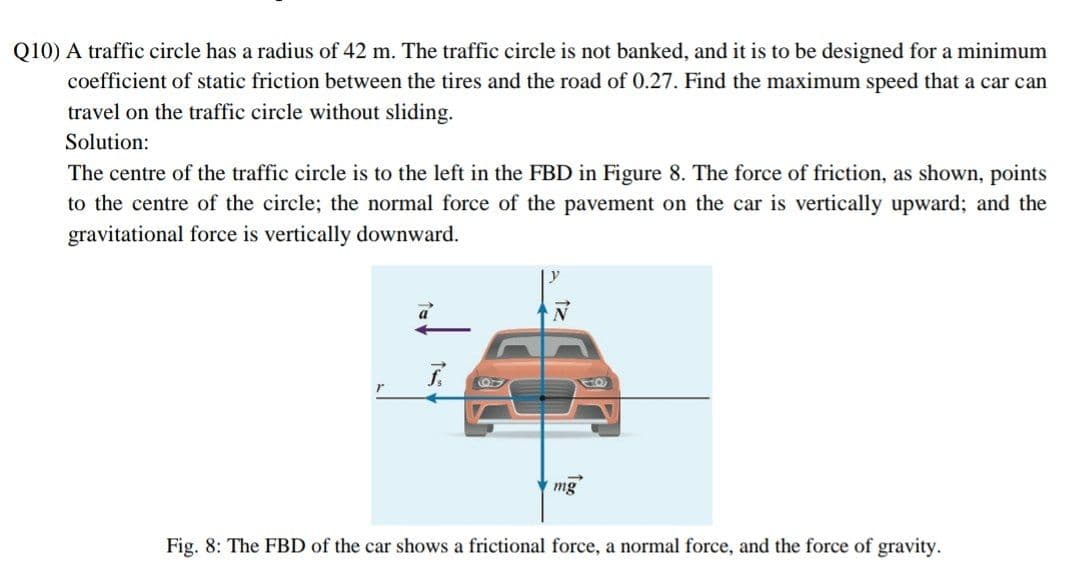A traffic circle has a radius of 42 m. The traffic circle is not banked, and it is to be designed for a minimum coefficient of static friction between the tires and the road of 0.27. Find the maximum speed that a car can travel on the traffic circle without sliding.
A traffic circle has a radius of 42 m. The traffic circle is not banked, and it is to be designed for a minimum coefficient of static friction between the tires and the road of 0.27. Find the maximum speed that a car can travel on the traffic circle without sliding.
Principles of Physics: A Calculus-Based Text
5th Edition
ISBN:9781133104261
Author:Raymond A. Serway, John W. Jewett
Publisher:Raymond A. Serway, John W. Jewett
Chapter5: More Applications Of Newton’s Laws
Section: Chapter Questions
Problem 19P: A crate of eggs is located in the middle of the flatbed of a pickup truck as the truck negotiates a...
Related questions
Question

Transcribed Image Text:Q10) A traffic circle has a radius of 42 m. The traffic circle is not banked, and it is to be designed for a minimum
coefficient of static friction between the tires and the road of 0.27. Find the maximum speed that a car can
travel on the traffic circle without sliding.
Solution:
The centre of the traffic circle is to the left in the FBD in Figure 8. The force of friction, as shown, points
to the centre of the circle; the normal force of the pavement on the car is vertically upward; and the
gravitational force is vertically downward.
a
mg
Fig. 8: The FBD of the car shows a frictional force, a normal force, and the force of gravity.
Expert Solution
This question has been solved!
Explore an expertly crafted, step-by-step solution for a thorough understanding of key concepts.
Step by step
Solved in 2 steps with 2 images

Knowledge Booster
Learn more about
Need a deep-dive on the concept behind this application? Look no further. Learn more about this topic, physics and related others by exploring similar questions and additional content below.Recommended textbooks for you

Principles of Physics: A Calculus-Based Text
Physics
ISBN:
9781133104261
Author:
Raymond A. Serway, John W. Jewett
Publisher:
Cengage Learning

Physics for Scientists and Engineers
Physics
ISBN:
9781337553278
Author:
Raymond A. Serway, John W. Jewett
Publisher:
Cengage Learning

Physics for Scientists and Engineers with Modern …
Physics
ISBN:
9781337553292
Author:
Raymond A. Serway, John W. Jewett
Publisher:
Cengage Learning

Principles of Physics: A Calculus-Based Text
Physics
ISBN:
9781133104261
Author:
Raymond A. Serway, John W. Jewett
Publisher:
Cengage Learning

Physics for Scientists and Engineers
Physics
ISBN:
9781337553278
Author:
Raymond A. Serway, John W. Jewett
Publisher:
Cengage Learning

Physics for Scientists and Engineers with Modern …
Physics
ISBN:
9781337553292
Author:
Raymond A. Serway, John W. Jewett
Publisher:
Cengage Learning

College Physics
Physics
ISBN:
9781938168000
Author:
Paul Peter Urone, Roger Hinrichs
Publisher:
OpenStax College

College Physics
Physics
ISBN:
9781285737027
Author:
Raymond A. Serway, Chris Vuille
Publisher:
Cengage Learning

Glencoe Physics: Principles and Problems, Student…
Physics
ISBN:
9780078807213
Author:
Paul W. Zitzewitz
Publisher:
Glencoe/McGraw-Hill